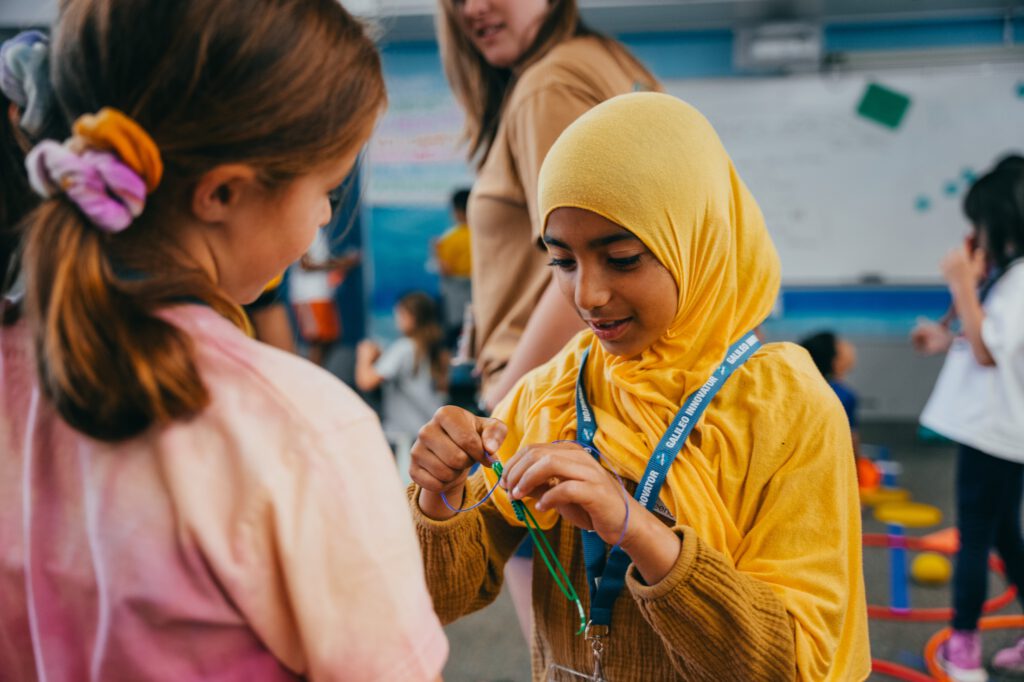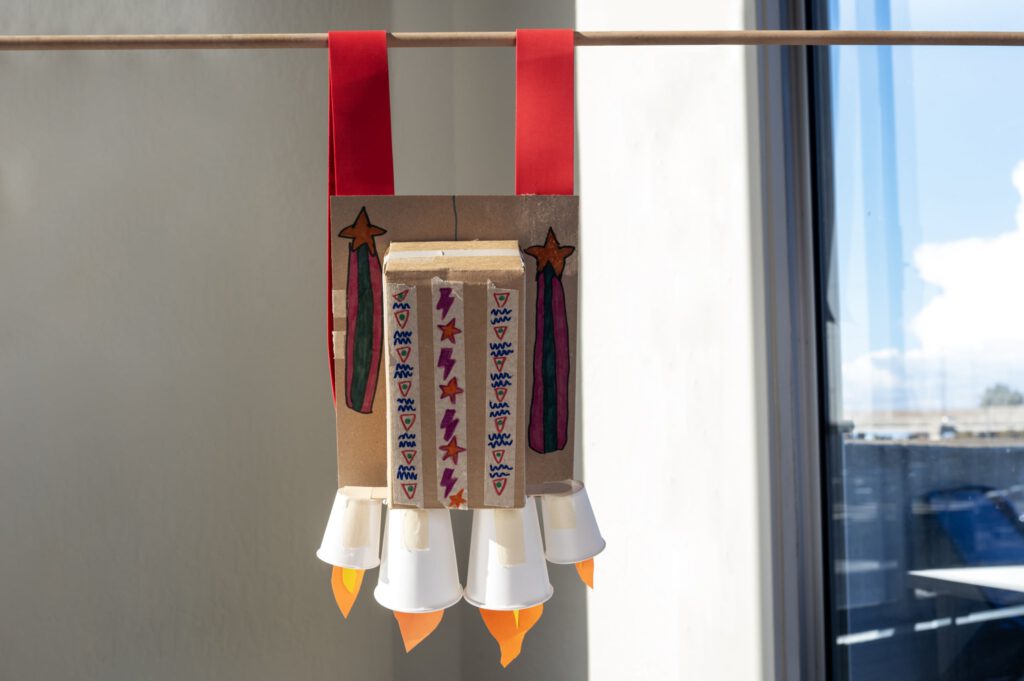When it comes time to play, don’t let a rainy day dash your plans! There are plenty of indoor children’s activities that can keep your child engaged and entertained, all while fostering their growth and development.

Today, we’re sharing some of our favorite indoor activities for kids. From arts and crafts to science experiments, and even important life skills like cooking, there’s no end to the possibilities your next rainy day can bring.
Creative Crafts and Artistic Projects
Arts and crafts always top lists of fun indoor activities for kids. And, thanks to your child’s robust imagination, you can get away with just a small handful of inexpensive supplies and still have an unforgettable afternoon.
Creative and artistic projects are also a fantastic way to nurture important skills, like:
- Creative thinking – This is a crucial part of problem-solving, a skill your child will use throughout their life. Not to mention, being able to look at nothing and create something from it can teach your kid to feel self-sufficient, capable and smart.
- Imaginative play – The ability to keep yourself entertained is a learned skill and one that serves the people who learn it well. By engaging in arts and crafts with simple household items, your child can learn firsthand that they don’t need other people or fancy toys to be amused and have fun.
- Motor skills – Of course, a big part of creating involves using your hands and eyes. Coordination, control, precision and fine motor skills all come into play when crafting.
You can come up with your own unique crafts projects with the items you already have at home, or look at lists of suggestions online. Often, you can find tutorials on everything from creating sock puppets to making your own chalk.
A few fun ideas that don’t require expensive materials include:
- Using cardboard tubes to make telescopes
- Creating a recycled guitar with an empty shoebox
- Making paper dinosaur slipper covers to wear around the house
Arts and crafts can teach your child how to find something amazing and entertaining even in everyday household items, so don’t be afraid to think outside the box with your projects.
Educational Games and Learning Fun
STEAM projects make for fun indoor children’s activities, too. Related to STEM, STEAM focuses on science, technology, engineering and math through the creative lens of the arts.
STEAM activities provide a great way to defend against “brain drain” by keeping your kid’s mind active and introducing them to new challenges. Your child’s brain is at its highest level of plasticity in their youngest years, so now’s the time to really get them engaged in these types of learning activities.
STEAM projects can also help with communication skills and fine motor skills as your child learns how to manipulate different materials like wire, paint, tape and metal.
Like arts and crafts, the items you need for STEAM projects are usually things you can find in your own home. This means STEAM activities can be budget-friendly and still deeply engaging.
Lists of STEM and STEAM activities are easy to find online, but a few of our favorites include:
- Building a bridge from upcycled materials
- Making a coin battery
- Egg painting with vinegar
Through these projects, your child can learn more about the principles of technology, engineering and science and how they work in real-world settings.
Fun and Interactive Science Experiments
Of course, a list of fun indoor activities for kids wouldn’t be complete without a few science experiments. While science experiments do come with the potential for a little mess, just remember: sometimes, getting messy is a part of life! Kids can always benefit from a little messy learning and the mistakes that may come with it.
Plus, there are plenty of benefits that outweigh any potential messiness. For instance, you can create most science experiments with household items you already own, and science activities encourage curiosity, exploration and problem-solving.
Here are just a few of our favorite science experiments for kids that you might want to try out:
- The water candle trick – Add water to a plate, and place a lit tea candle on the plate. Then, place a glass cup over the candle. You’ll see Charles’s Law in action as the flame eats away the oxygen and heats the glass, causing the water inside the glass to rise.
- Dish soap and glitter – Fill a container with water and glitter. Then, slowly add dish soap. You’ll see that dish soap repels glitter when both are in the same container. This is a great way to show your child how washing their hands properly can keep germs at bay.
- Apple slice oxidation – With this experiment, your child can see firsthand the oxidation process that causes foods to brown when exposed to oxygen. Start by slicing up an apple. Then, cover each slice of apple with a different solution—apple juice, lemonade, pure lemon juice, salt water, sugar water and plain water. Leave the slices on a plate for 10 to 20 minutes, exposing them to air. Over time, the oxidation process will turn the slices brown—but some will brown faster than others!
- Water density – Show your child how hot and cold water sit at different densities with a simple experiment using water, food coloring and mason jars. Start by filling one jar with hot water and one with cold water. Make sure to add different food coloring to each jar. Then, use a laminated card to cover the mouth of the hot jar, flip it upside down onto the jar filled with cold water and slide the card out. The colored waters will stay separated as if by magic—and this is where you can explain how temperature affects density.
Cooking Adventures in the Kitchen
Cooking is often overlooked in the realm of indoor children’s activities, but it’s a hugely rewarding experience that incorporates a wide array of skills. By joining you in the kitchen, your child can:
- Develop a more varied palate
- Learn an important life skill
- Cultivate the habit of eating home-cooked meals
- Work on fine motor skills and hand-eye coordination
- Build confidence and self-sufficiency
- Strengthen familial bonds
On top of that, your child will experience the satisfaction and pride that comes from cooking something from scratch and enjoying a delicious meal with others. Cooking activities also show your child that they’re capable of doing something they may see as being “for adults only”—using kitchen tools and whipping up food.
Start by searching for kid-friendly recipes to try, and if you’re worried about your kid handling certain tools or kitchen equipment, you can always let them help you with safer tasks like mixing, rolling, filling and pouring.
Sure, it may result in a little extra clean-up, but the payoff will be well worth it!
Imaginative Playtime and Storytelling
Storytelling and imaginative playtime sessions are two more great ways to keep your child’s brain engaged and growing.
Act Out Fantastic Tales
Kids with a flair for dramatics will especially love this activity, but just about anyone can enjoy engaging in a little active storytelling. Choose a favored fairytale to act out, or let your little ones come up with their very own story complete with characters that they can flesh out with names, backgrounds, jobs and dreams.
If you really want to make it an immersive experience, you can even add some extra steps like creating costumes and props or building “sets.”
Think Up a Whole New World
Playing pretend is often second nature to kids with active imaginations, and when you engage in the activity with them, they’re encouraged to be creative and have confidence in their ideas.
If you’re looking for fun ways to play pretend with your child, consider:
- A tea party with royalty
- Secret agents on a special mission
- Astronauts building a new space station
- Ocean explorers discovering new creatures at the bottom of the sea
Ultimately, the world’s your oyster when it comes to playing pretend. And the best part? You can usually get away with minimal props, all of which you can find in your own home. After all, the aim of the game is to expand your child’s creativity and imagination—and what better way to do that than by using simplistic tools and props, or nothing at all?
Enjoy All-Weather Fun at Camp Galileo

Whether it’s beautiful and sunny outside or downcast and rainy, summer camps provide ample opportunities for your child to play, learn and make unforgettable memories—and that’s where Camp Galileo comes in.
At Camp Galileo, your child will build robots, dig up dinosaur bones, explore interesting areas of arts and crafts and create one-of-a-kind projects to take home with them at the end of every week.
In the process, they’ll also build important life skills like communication, socialization, cooperation and coordination. On top of that, successfully engaging in creative activities and challenging puzzles can give them the confidence they need to tackle bigger problems in the future. Put simply, Camp Galileo gives children the tools they need to grow and thrive—not just on a rainy day, but well into their adult lives!
If you’re interested in helping your child gain important life skills, continue learning and growing even outside of school and do it all while having the time of their life, look no further than Camp Galileo. Enroll today and ensure a future summer experience your child won’t ever forget.
Sources:
Highlights. 31 Arts and Crafts for Kids to Make at Home. https://parents.highlights.com/31-arts-and-crafts-kids-to-make-home
Left Brain Craft Brain. 28 Days of STEM Activities and STEAM Activities for Kids. https://leftbraincraftbrain.com/28-days-of-stem-activities-and-steam-activities-for-kids/
We Are Teachers. 70 Easy Science Experiments Using Materials You Already Have On Hand. https://www.weareteachers.com/easy-science-experiments/
Healthy Little Foodies. The Benefits of Cooking With Kids. https://www.healthylittlefoodies.com/the-benefits-of-cooking-with-kids/






